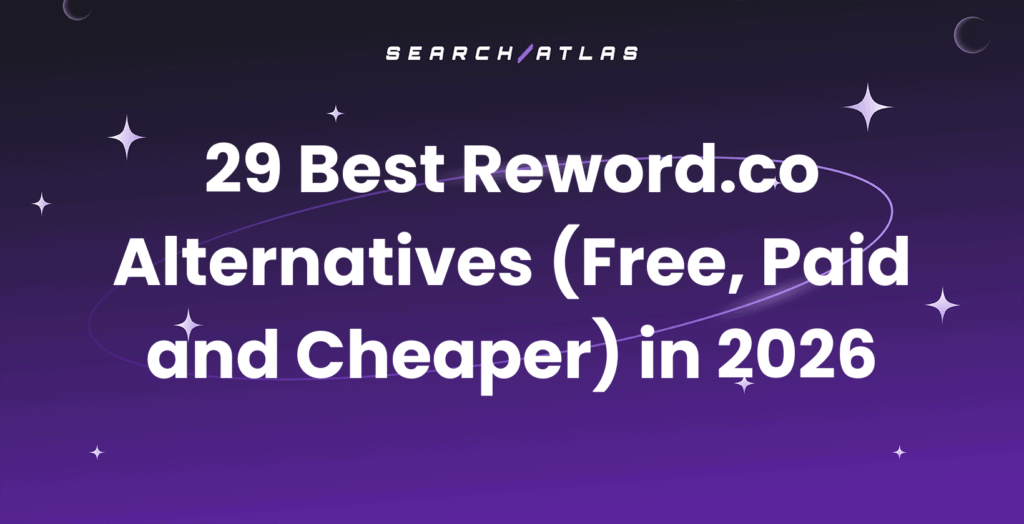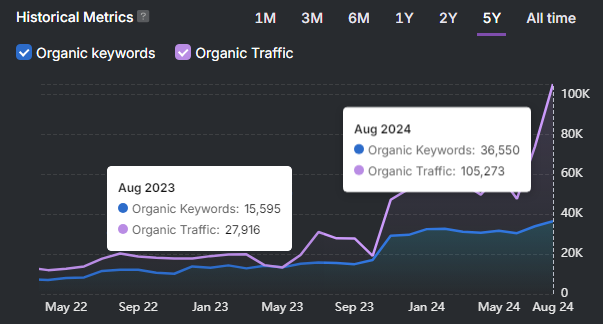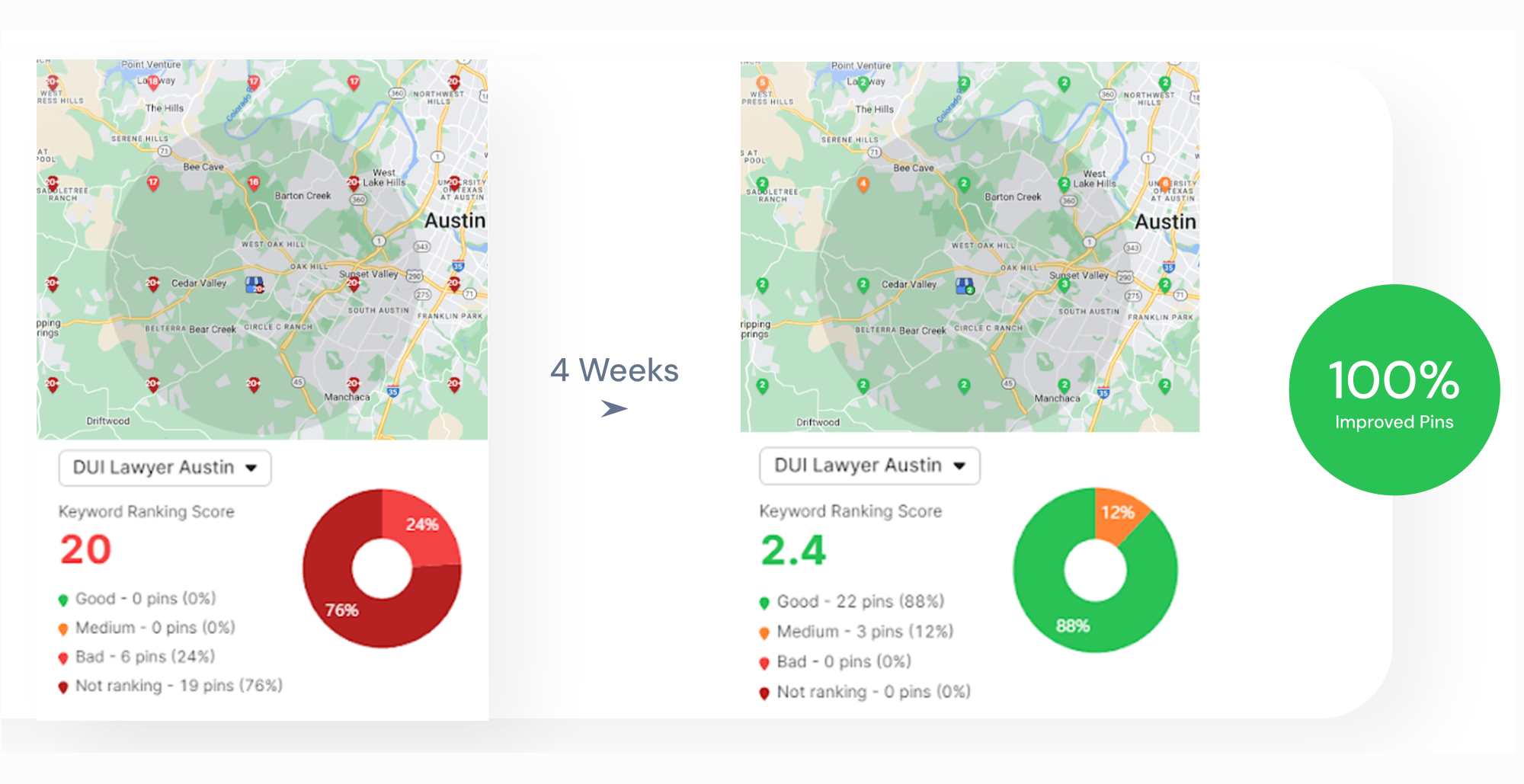Seasonal keywords are search terms that experience a clear surge in search volume during specific times of the year, such as holidays or events. Seasonal keywords are important for SEO as well as business success, as they increase visibility, conversions, and other performance indicators.
We explain ways to find, incorporate, and track seasonal keywords.
What Are Seasonal Keywords?
Seasonal keywords are search terms that experience a clear surge in search volume during specific times of the year. This rise follows predictable patterns. For example, “Christmas gift ideas” trends heavily in December, while “back to school supplies” peaks in late summer.

What Types of Seasonal Keywords Are There?
Seasonal keywords fall into distinct categories based on their timing and triggers. Each category responds to different consumer behaviors and search patterns throughout the year. Understanding these categories helps businesses target their content and advertising strategies more effectively.
Holiday-Focused Keywords
Holiday-focused keywords center around specific celebrations and observances throughout the year. These terms experience dramatic spikes in search volume before and during particular holidays. Christmas, Halloween, Valentine’s Day, and Thanksgiving generate some of the highest search volumes in this category. Religious holidays like Easter and Hanukkah create significant search activity within their respective communities.
The search patterns for holiday keywords typically begin weeks or months before the actual holiday. Consumers search for gift ideas, decorations, recipes, and travel plans well in advance. This early search behavior creates opportunities for businesses to capture traffic before competitors recognize the trend, which is called holiday SEO.
Weather-Dependent Keywords
Weather-dependent keywords fluctuate with seasonal climate changes and weather patterns. These terms relate directly to activities, products, and services that people need during specific weather conditions. Winter keywords include terms like “snow removal,” “winter coats,” and “heating repair.” Summer keywords encompass “air conditioning,” “swimming pools,” and “outdoor grills.”
Geographic location heavily influences weather-dependent keyword performance. A keyword that peaks in December in northern regions might peak in June in southern hemisphere locations. Businesses consider their target market’s climate patterns when they plan campaigns around weather-dependent terms.
Event-Driven Keywords
Event-driven keywords revolve around scheduled events, activities, and occasions that occur at predictable times each year. Back-to-school season generates searches for supplies, clothing, and educational materials. Tax season creates demand for accounting services, software, and filing assistance. Sports seasons drive searches for team merchandise, tickets, and viewing parties.
These keywords often have longer preparation periods than other seasonal terms. Parents start searching for school supplies in mid-summer, and tax-related searches begin in January for April deadlines. The preparation phase creates extended opportunities for businesses to capture relevant traffic before peak demand periods arrive.
Why Do Seasonal Keywords Matter for SEO?
Seasonal keywords bring in high-volume traffic during peak interest periods. Seasonal keywords have several SEO benefits that we discuss below.
Increased Visibility
High-volume queries rise at predictable times. For example, “April 15 tax help” draws millions of searches before the U.S. tax deadline. Websites that post early rise with the trend and stay visible throughout the peak. Seasonal keywords are an essential part of a wider holiday SEO strategy.
Higher Engagement
Timely content improves interaction. For example, articles about “spring allergy tips” receive longer sessions and lower bounce rates during March and April. Marketers use this seasonal alignment to build user trust and keep readers on-site.
Timely Relevance
News-related and event-driven terms increase relevance. During the Oscars, “Academy Awards winners list” trends. A film site publishes nominee predictions or live updates. This real-time coverage connects with active search behavior.
Enhanced Conversion Potential
Users often buy based on time-specific needs. For example, the keyword “snow chains for tires” spikes before the first winter storm. Retailers that prepare content and stock early convert seasonal urgency into revenue.
Competitive Advantage
Target seasonal keywords before competitors notice the trend. For example, some stores optimize early for the “college dorm checklist” in May. Sites that rank first by June dominate traffic in July and August.
Targeted Traffic
Traffic that comes through seasonal keywords tends to convert better. For example, “Father’s Day grill sets” draw users who already plan to buy. Offer specific landing pages and guide users to quick purchases.
Strategic Content Planning
Seasonal keywords help with structured content calendars. For example, a pet store plans posts on “keeping pets warm in winter” for December, and “tick prevention for dogs” in April. Content stays aligned with what audiences seek.
Alignment With Search Trends
Search demand changes fast. For example, “solar eclipse glasses” trend during eclipse years. SEO teams that adjust with real-world events reach users who show immediate intent and interest.
Increased Ranking Potential
Search engines prioritize freshness. Pages that address current needs outperform stale ones. For example, a city guide with “summer concert schedules” ranks quickly and dominates local queries through the season.
How to Find Seasonal Keywords
Businesses and marketers find seasonal keywords by using Google Trends, keyword research tools, and competitor analysis.
Use Google Trends
Google Trends serves as the primary tool for discovering seasonal keyword patterns. Navigate to Google Trends and enter your seed keyword in the search box. Set the date range to either 12 months for recent patterns or 5 years for comprehensive trend analysis.
The tool displays search interest over time as a line graph. Use Google trends to look for clear peaks that occur during specific months and repeat annually. These recurring spikes indicate seasonal behavior.
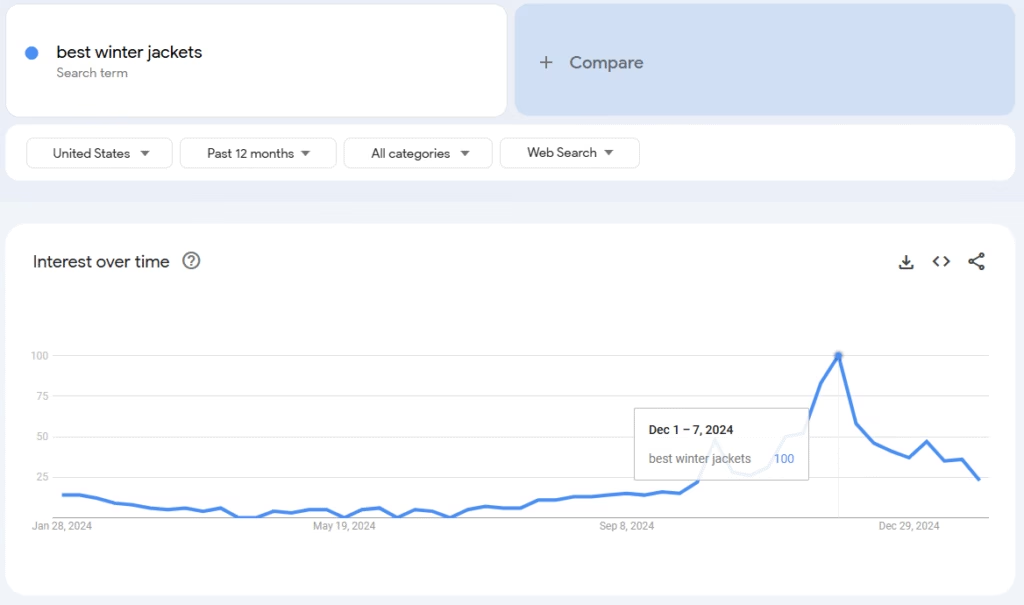
Hover your cursor over different points on the trend line to view exact dates when interest rises and falls. This data reveals the precise timing for seasonal campaigns. Compare multiple related keywords by entering them together to identify which terms perform best during specific seasons.
Filter results by geographic region if your business targets specific locations. Seasonal patterns vary significantly between different countries and climates.
Use Keyword Research Tools
Google Search Console and Keyword Researcher provide comprehensive data for identifying and analyzing seasonal keyword opportunities. These tools reveal historical search patterns and help businesses time their seasonal campaigns effectively.
Start by examining historical search volume data for your target keywords. The example below shows how “Christmas sweaters” trends dramatically in the United States during December, with search volume spiking from nearly zero in summer months to peak levels during the holiday season.
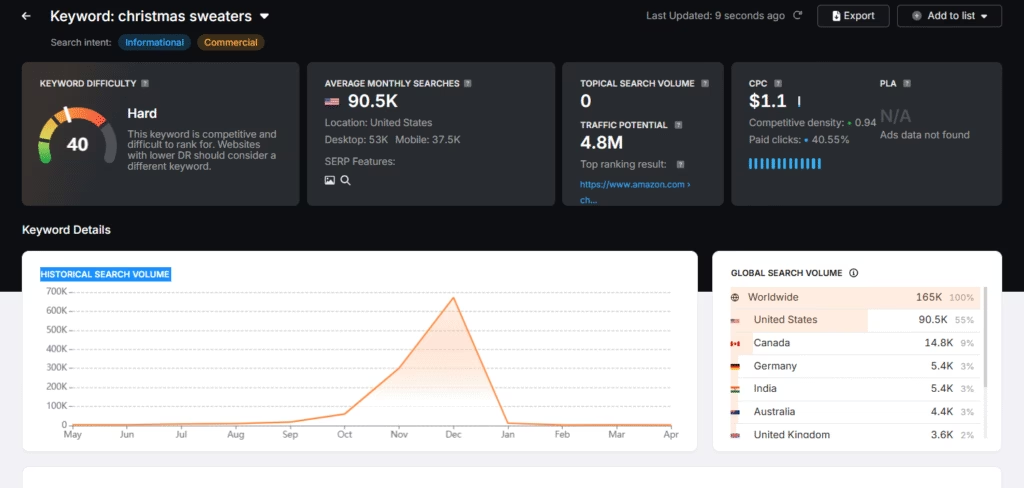
This pattern demonstrates the importance of timing seasonal campaigns correctly. Retailers who optimize for Christmas sweater keywords in October and November capture traffic before the December surge reaches its peak. Those who wait until December face maximum competition and higher advertising costs.
There are 4 steps to identifying seasonal trends. The steps are listed below.
- Input your target keywords into Google Search Console or Keyword Researcher.
- Look for recurring spikes that occur during the same months each year. These spikes indicate strong seasonal behavior that you leverage for campaign planning.
- Compare multiple related keywords to identify which terms perform best during specific seasons. Some variations might peak earlier or later than your primary keywords.
- Document peak timing for each seasonal keyword you discover. Note when search volume begins to rise, reaches its peak, and returns to baseline levels.
Monitor Competitor Keywords
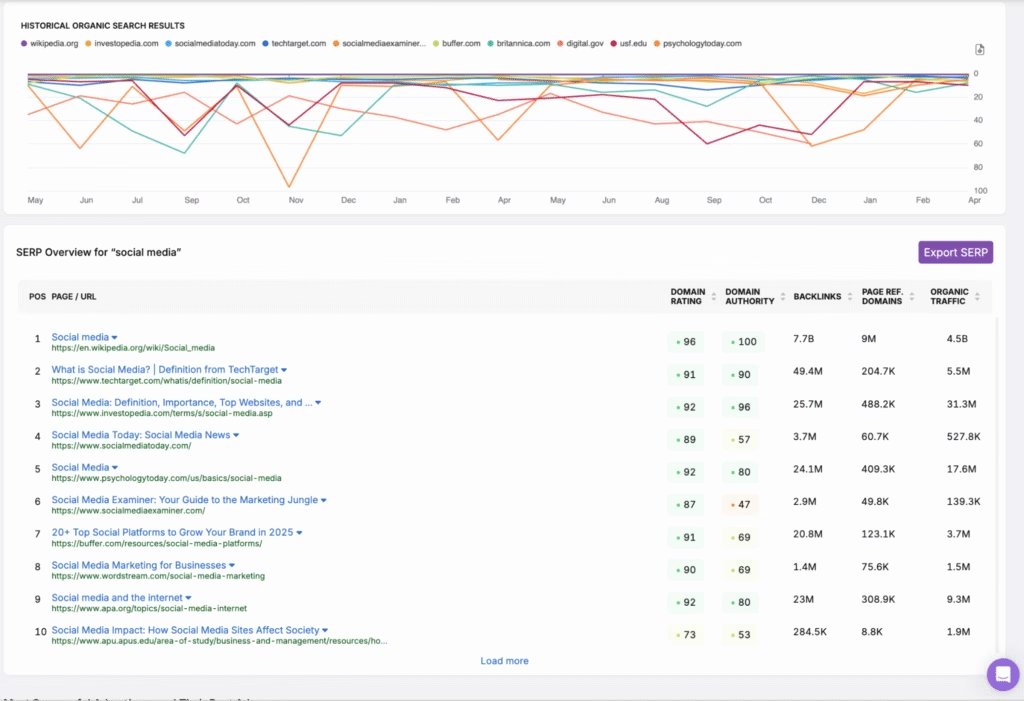
Search Atlas Keyword Research Tool provides comprehensive competitor analysis through systematic examination of top-ranking pages. To analyze competitor keywords effectively, follow the 6 steps listed below.
- Enter your target keyword into the Search Atlas Keyword Research Tool interface. The tool displays SERP results with detailed metrics for analysis.
- Examine the top 10 URLs that appear in the SERP overview section. Note each competitor’s domain authority, backlink profile, and traffic estimates which the tool provides. Analyze SERP competitors ranking in detail to understand why the pages are successful.
- Analyze what makes these pages rank highly by examining their content patterns. Determine whether they use definition-style content, listicles, tool mentions, or other formats. Count their average word count and observe how frequently they use headers, images, and internal links.
- Click on each URL to assess topical depth and content coverage. Compare formats between different competitors to identify common patterns.
- Identify the content type, alignment with keyword intent, and page architecture that align with search engine expectations after you complete your analysis.
- Use this intelligence from Search Atlas to guide your content creation process. Structure your content outlines, formatting choices, and supporting elements based on what successful competitors demonstrate.
How to Use Seasonal Keywords in Your Strategy
Seasonal content optimization improves SEO by capturing traffic during peak demand periods and maintaining relevance for cyclical search behaviors. Timely seasonal content delivers significant traffic increases during relevant seasons when competitors scramble to publish last-minute material.
Plan Content to Match User Intent
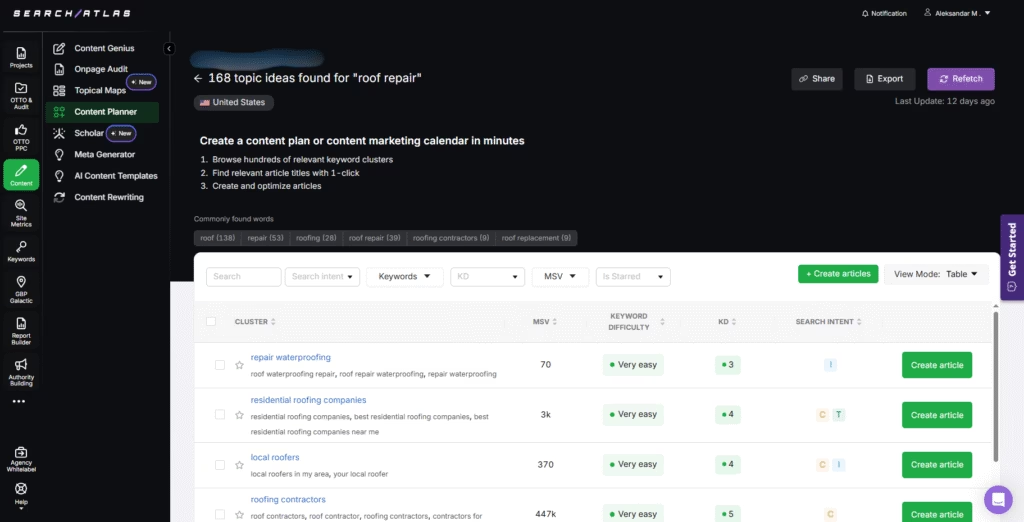
Advanced planning prevents missed opportunities and ensures content goes live before peak demand windows arrive. Seasonal keywords perform most effectively when businesses use them in product pages, landing pages, and blog content published during the build-up phase rather than at the peak itself.
Strategic content scheduling allows time for proper optimization, link building, and indexing before the crucial seasonal period begins. This preparation gives content the best chance to rank highly when search volume spikes occur.
The Search Atlas Content Planner Tool generates comprehensive keyword clusters from a single seed keyword and reveals content opportunities across entire topic areas. To maximize your seasonal content planning, follow the steps below.
- Enter your seasonal seed keyword into the Search Atlas Content Planner Tool interface. The tool generates keyword clusters that highlight related secondary keywords, subtopics, and search intent variations.
- Review each cluster that the tool creates. Each cluster often corresponds to a single article and shows search volume, competition levels, and intent behind each keyword.
- Examine the secondary keywords that the tool automatically uncovers. These keywords cover everything that falls under your broad seed keyword and reveal gaps in your current content strategy.
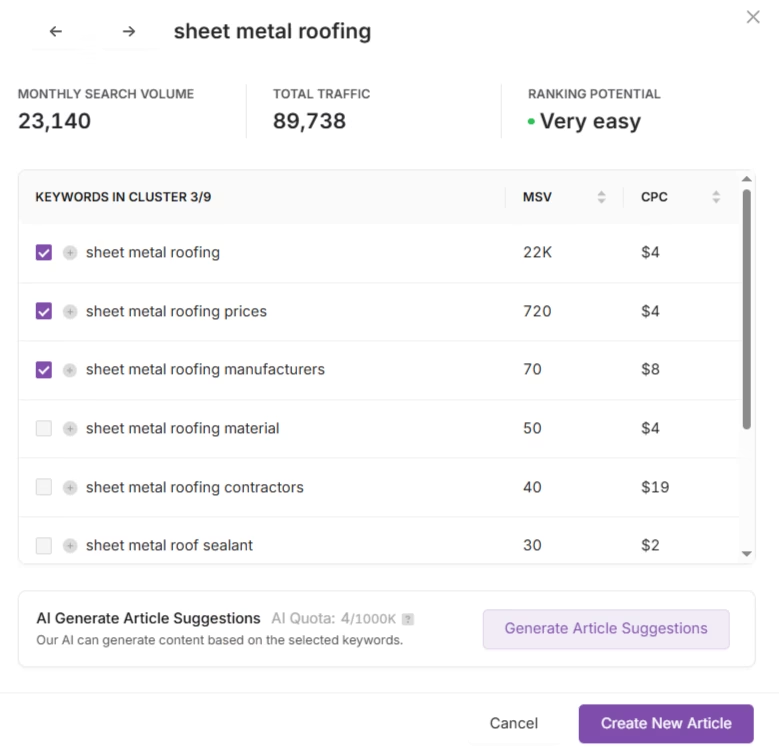
- Analyze the search volume and competition data for each cluster to prioritize which content pieces to create first.
- Schedule content creation in advance of peak demand periods after you identify the seasonal timing for each keyword cluster.
- Plan publishing dates during the build-up phase rather than waiting for peak season to arrive.
- Update your content calendar using the Search Atlas data to align publishing schedules with seasonal demand cycles throughout the year.
Incorporate Them Into Your Local SEO Strategy
Customers search for seasonal services, products, and events within their geographic area. Consider a local cake business that targets wedding season traffic. Wedding season runs from May to October in most US regions, with variations based on local climate patterns and cultural preferences.
The local cake business needs to optimize for keywords such as “wedding cakes [city name],” “custom wedding desserts near me,” and “bridal shower cakes [region]” during the months leading up to peak wedding season.
There are several ways the business use seasonal keywords in its strategy. These are listed below.
- Local SEO Heatmaps. Set up heatmap tracking for your primary seasonal keywords before each seasonal period begins. Monitor how rankings change as seasonal demand increases and track improvements or declines in different geographic areas. Local search grid data reveals which local optimization strategies work best.
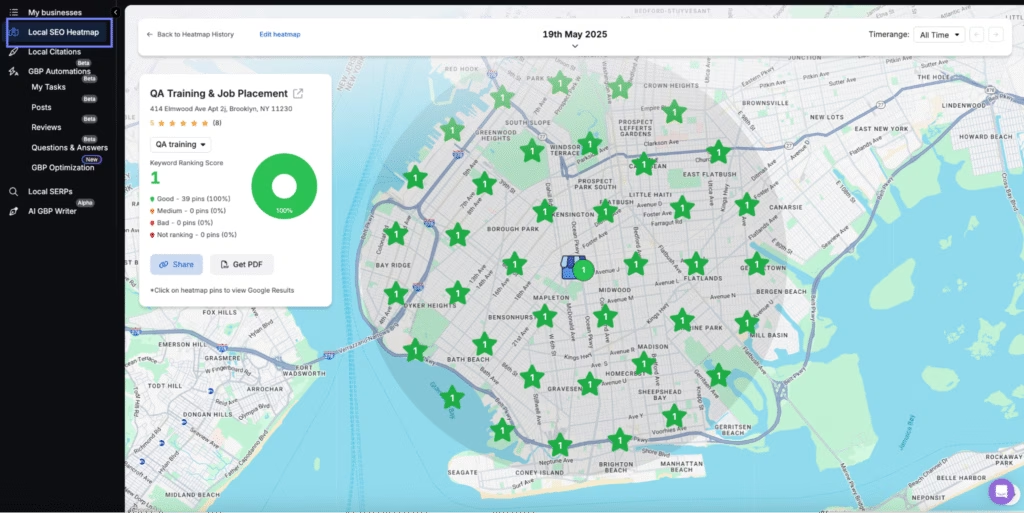
- Localized Landing Pages. Create location-specific landing pages for major seasonal keywords. A landscaping business might create separate pages for “spring lawn care [neighborhood name]” and “fall leaf removal [city name].” Each page should include local landmarks, neighborhood-specific information, and seasonal services relevant to that particular area.
- Location-specific Keyword Research. Track seasonal search patterns with local keyword research. Some regions experience different seasonal timing due to climate variations. Northern cities might see “snow removal” searches starting in October, while southern regions focus on “hurricane preparation” during similar timeframes.
- Localized Content. Engage with local seasonal events and activities through content creation. Write blog posts about local festivals, seasonal activities, or community events that relate to your business. This content helps establish local authority and captures searches from people looking for seasonal activities in your area.
Measure Success and Adjust in Real Time
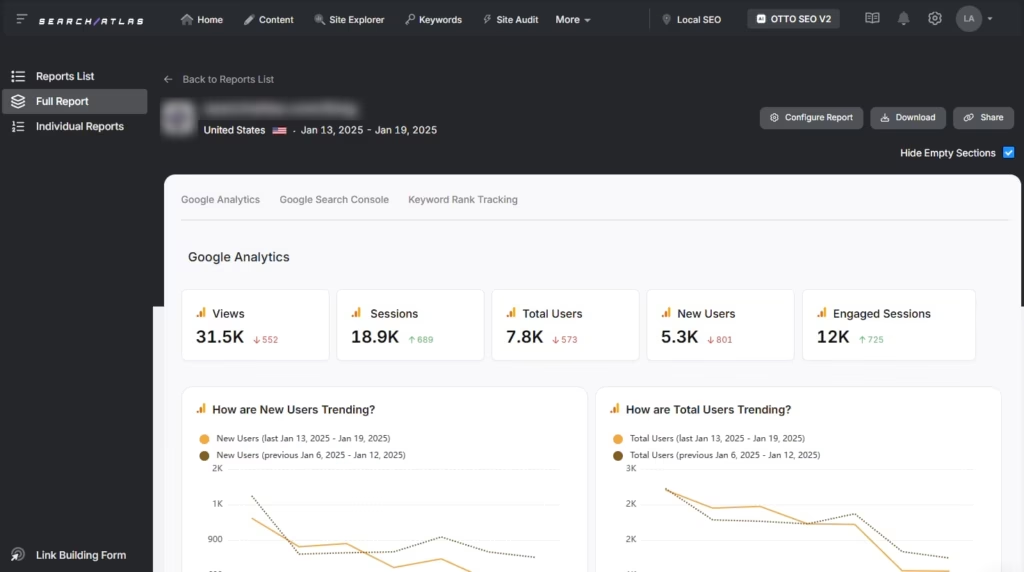
Performance measurement becomes critical after seasonal campaigns launch. Track multiple metrics to understand what resonates with your audience and what needs improvement for future seasons.
- Analyze Content Effectiveness. Examine how specific pieces perform during campaigns. For example, measure engagement rates for colorful backpacks during summer campaigns or track conversion rates for exam prep materials in spring.
- Assess Engagement Across Content Types. Blog posts attract readers who want detailed guides while social media updates appeal to users who prefer quick information. Product videos serve visual learners who need demonstrations.
- Use Google Analytics for Detailed Insights. Navigate to the Engagement tab and set your measurement period to match your seasonal campaign. Review session duration, bounce rate, and user flow patterns to understand visitor behavior.
- Examine Performance Indicators. Review sales figures, website traffic patterns, and customer feedback to identify successful elements.
- Identify Gaps and Opportunities. Look for underperforming keywords, failed content formats, or timing issues where content went live too late in the seasonal cycle.
- Make Real-time Adjustments. Monitor daily performance metrics during active campaigns. Make immediate changes to content, keywords, or promotion strategies when performance falls below expectations.
- Create Comprehensive Reports. Develop detailed reports after each seasonal period ends. Use automated reporting tools with GSC and GA4 integrations.
Stay On Top of Seasonal Keyword Trends With AI Tools
Seasonal keywords provide businesses with predictable opportunities to capture high-intent traffic during specific time periods throughout the year. These keywords follow clear patterns that repeat annually, which makes them valuable for strategic planning and content optimization.
Planning a seasonal keyword strategy requires fast acting. Automation tools like Search Atlas help marketers and businesses gain control of seasonal keywords with a full digital marketing platform that works with key integrations.
Try Search Atlas FREE for 7 days and win the top keywords the next season.


